Characterization of the SIDDHARTA-2 Setup via the Kaonic Helium Measurement
Abstract
1. Introduction
2. The SIDDHARTA-2 Setup on DAΦNE
3. Calibration Procedure and Data Analysis
3.1. SDDs Calibration in DAΦNE
3.2. Data Selection
3.3. Degrader Optimization
4. The Kaonic Helium-4 Energy Shift and Width
5. Conclusions
Author Contributions
Funding
Data Availability Statement
Acknowledgments
Conflicts of Interest
References
- Tomonaga, S.; Araki, G. Effect of the nuclear Coulomb field on the capture of slow mesons. Phys. Rev. 1940, 58, 90. [Google Scholar] [CrossRef]
- Meißner, U.G.; Raha, U.; Rusetsky, A. Spectrum and decays of kaonic hydrogen. Eur. Phys. J.-Part. Fields 2004, 35, 349–357. [Google Scholar] [CrossRef]
- Meißner, U.G.; Raha, U.; Rusetsky, A. Kaon–nucleon scattering lengths from kaonic deuterium experiments. Eur. Phys. J.-Part. Fields 2006, 47, 473–480. [Google Scholar] [CrossRef][Green Version]
- Lee, C.H.; Jung, H.; Min, D.P.; Rho, M. Kaon-nucleon scattering from chiral Lagrangians. Phys. Lett. B 1994, 326, 14–20. [Google Scholar] [CrossRef][Green Version]
- Bernard, V. Chiral Perturbation Theory and Baryon Properties. Prog. Part. Nucl. Phys. 2008, 60, 82–160. [Google Scholar] [CrossRef]
- Cieplý, A.; Mai, M.; Meißner, U.G.; Smejkal, J. On the pole content of coupled channels chiral approaches used for the N system. Nucl. Phys. A 2016, 954, 17–40. [Google Scholar] [CrossRef]
- Mai, M.; Meissner, U.G. New insights into antikaon-nucleon scattering and the structure of the Λ(1405). Nucl. Phys. A 2013, 900, 51–64. [Google Scholar] [CrossRef]
- Guo, Z.H.; Oller, J.A. Meson-baryon reactions with strangeness −1 within a chiral framework. Phys. Rev. C 2013, 87, 035202. [Google Scholar] [CrossRef]
- Ikeda, Y.; Hyodo, T.; Weise, W. Chiral SU(3) theory of antikaon-nucleon interactions with improved threshold constraints. Nucl. Phys. A 2012, 881, 98–114. [Google Scholar] [CrossRef]
- Cieply, A.; Friedman, E.; Gal, A.; Gazda, D.; Mares, J. Chirally motivated K− nuclear potentials. Phys. Lett. B 2011, 702, 402–407. [Google Scholar] [CrossRef]
- Cieply, A.; Friedman, E.; Gal, A.; Gazda, D.; Mares, J. K− nuclear potentials from in-medium chirally motivated models. Phys. Rev. C 2011, 84, 045206. [Google Scholar] [CrossRef]
- Liu, Z.W.; Wu, J.J.; Leinweber, D.B.; Thomas, A.W. Kaonic Hydrogen and Deuterium in Hamiltonian Effective Field Theory. Phys. Lett. B 2020, 808, 135652. [Google Scholar] [CrossRef]
- Révai, J. Three-body calculation of the 1s level shift in kaonic deuterium with realistic N potentials. Phys. Rev. C 2016, 94, 054001. [Google Scholar] [CrossRef]
- Bazzi, M.; Beer, G.; Bombelli, L.; Bragadireanu, A.; Cargnelli, M.; Corradi, G.; Curceanu, C.; Fiorini, C.; Frizzi, T.; Ghio, F.; et al. A new measurement of kaonic hydrogen X-rays. Phys. Lett. B 2011, 704, 113–117. [Google Scholar] [CrossRef]
- Bazzi, M.; Beer, G.; Bombelli, L.; Bragadireanu, A.; Cargnelli, M.; Corradi, G.; Curceanu, C.; d’Uffizi, A.; Fiorini, C.; Frizzi, T.; et al. Kaonic helium-4 X-ray measurement in SIDDHARTA. Phys. Lett. B 2009, 681, 310–314. [Google Scholar] [CrossRef]
- Milardi, C.; Alesini, D.; Bini, S.; Blanco-García, O.; Boscolo, M.; Cantarella, S.; Caschera, S.; Castorina, G.; Chavanne, J.; D’Uffizi, A.; et al. Preparation Activity for the Siddharta-2 Run at DAΦNE. In Proceedings of the 9th International Particle Accelerator Conference, Vancouver, BC, Canada, 29 April–4 May 2018; pp. 334–337. [Google Scholar] [CrossRef]
- Curceanu, C.; Guaraldo, C.; Iliescu, M.; Cargnelli, M.; Hayano, R.; Marton, J.; Zmeskal, J.; Ishiwatari, T.; Iwasaki, M.; Okada, S.; et al. The modern era of light kaonic atom experiments. Rev. Mod. Phys. 2019, 91, 025006. [Google Scholar] [CrossRef]
- Bazzi, M.; Berucci, C.; Curceanu, C.; d’Uffizi, A.; Iliescu, M.; Sbardella, E.; Scordo, A.; Shi, H.; Sirghi, F.; Tatsuno, H.; et al. Characterization of the SIDDHARTA-2 second level trigger detector prototype based on scintillators coupled to a prism reflector light guide. J. Instrum. 2013, 8, T11003. [Google Scholar] [CrossRef][Green Version]
- Tüchler, M.; Amsler, C.; Bazzi, M.; Bosnar, D.; Bragadireanu, M.; Cargnelli, M.; Clozza, A.; Deda, G.; Grande, R.D.; Paolis, L.D.; et al. The SIDDHARTA-2 Veto-2 system for X-ray spectroscopy of kaonic atoms at DAΦNE. J. Instrum. 2023, 18, P11026. [Google Scholar] [CrossRef]
- Tüchler, M.; Zmeskal, J.; Amirkhani, A.; Bazzi, M.; Bellotti, G.; Berucci, C.; Bosnar, D.; Bragadireanu, A.; Cargnelli, M.; Curceanu, C.; et al. A charged particle veto detector for kaonic deuterium measurements at DAΦNE. In Proceedings of the 10th International Conference on Precision Physics of Simple Atomic Systems, Vienna, Austria, 14–18 May 2018; IOP Publishing: Bristol, UK, 2018; Volume 1138, p. 012012. [Google Scholar]
- Gatti, E.; Rehak, P. Semiconductor drift chamber—An application of a novel charge transport scheme. Nucl. Instrum. Methods Phys. Res. 1984, 225, 608–614. [Google Scholar] [CrossRef]
- Gatti, E.; Rehak, P.; Walton, J.T. Silicon drift chambers: First results and optimum processing of signals. Nucl. Instrum. Methods A 1984, 226, 129–141. [Google Scholar] [CrossRef]
- Miliucci, M.; Scordo, A.; Sirghi, D.; Amirkhani, A.; Baniahmad, A.; Bazzi, M.; Bosnar, D.; Bragadireanu, M.; Carminati, M.; Cargnelli, M.; et al. Silicon drift detectors system for high-precision light kaonic atoms spectroscopy. Meas. Sci. Technol. 2021, 32, 095501. [Google Scholar] [CrossRef]
- Miliucci, M.; Iliescu, M.; Sgaramella, F.; Bazzi, M.; Bosnar, D.; Bragadireanu, M.; Carminati, M.; Cargnelli, M.; Clozza, A.; Curceanu, C.; et al. Large area silicon drift detectors system for high precision timed X-ray spectroscopy. Meas. Sci. Technol. 2022, 33, 095502. [Google Scholar] [CrossRef]
- Sgaramella, F.; Miliucci, M.; Bazzi, M.; Bosnar, D.; Bragadireanu, M.; Carminati, M.; Cargnelli, M.; Clozza, A.; Deda, G.; De Paolis, L.; et al. The SIDDHARTA-2 calibration method for high precision kaonic atoms X-ray spectroscopy measurements. Phys. Scr. 2022, 97, 114002. [Google Scholar] [CrossRef]
- Skurzok, M.; Khreptak, A. Efficiency analysis and promising applications of silicon drift detectors. Bio-Algorithms Med-Syst. 2023, 19, 74–79. [Google Scholar]
- Skurzok, M.; Scordo, A.; Niedzwiecki, S.; Baniahmad, A.; Bazzi, M.; Bosnar, D.; Bragadireanu, M.; Carminati, M.; Cargnelli, M.; Clozza, A.; et al. Characterization of the SIDDHARTA-2 luminosity monitor. J. Instrum. 2020, 15, P10010. [Google Scholar] [CrossRef]
- Sirghi, F.; Sgaramella, F.; Abbene, L.; Amsler, C.; Bazzi, M.; Borghi, G.; Bosnar, D.; Bragadireanu, M.; Buttacavoli, A.; Carminati, M.; et al. SIDDHARTA-2 apparatus for kaonic atoms research on the DA Φ NE collider. arXiv 2023, arXiv:2311.16144. [Google Scholar]
- Van Gysel, M.; Lemberge, P.; Van Espen, P. Implementation of a spectrum fitting procedure using a robust peak model. X-ray Spectrom. Int. J. 2003, 32, 434–441. [Google Scholar] [CrossRef]
- Okada, S.; Beer, G.; Bhang, H.; Cargnelli, M.; Chiba, J.; Choi, S.; Curceanu, C.; Fukuda, Y.; Hanaki, T.; Hayano, R.; et al. Precision measurement of the 3d → 2p X-ray energy in kaonic 4He. Phys. Lett. B 2007, 653, 387–391. [Google Scholar] [CrossRef]
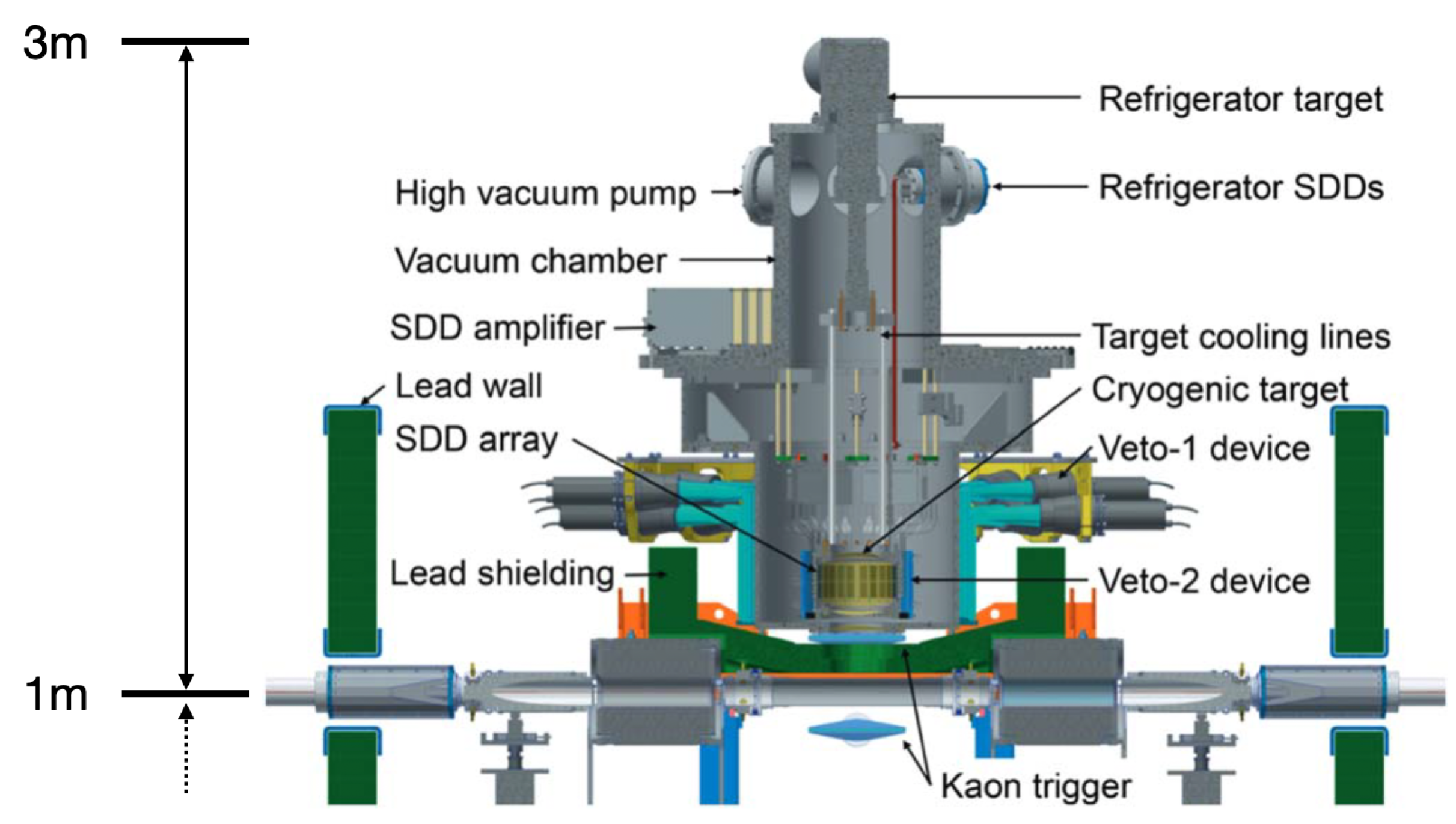
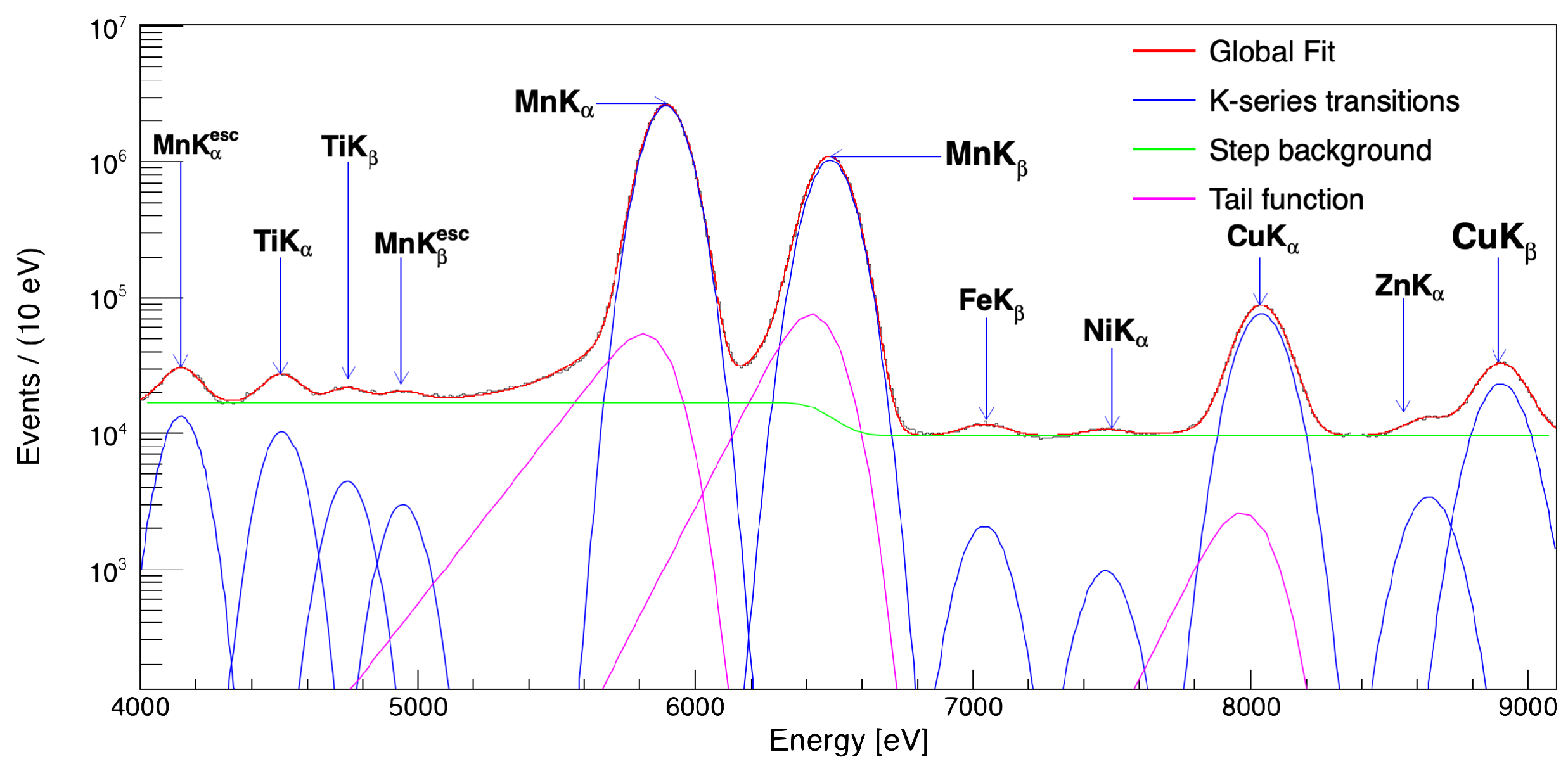
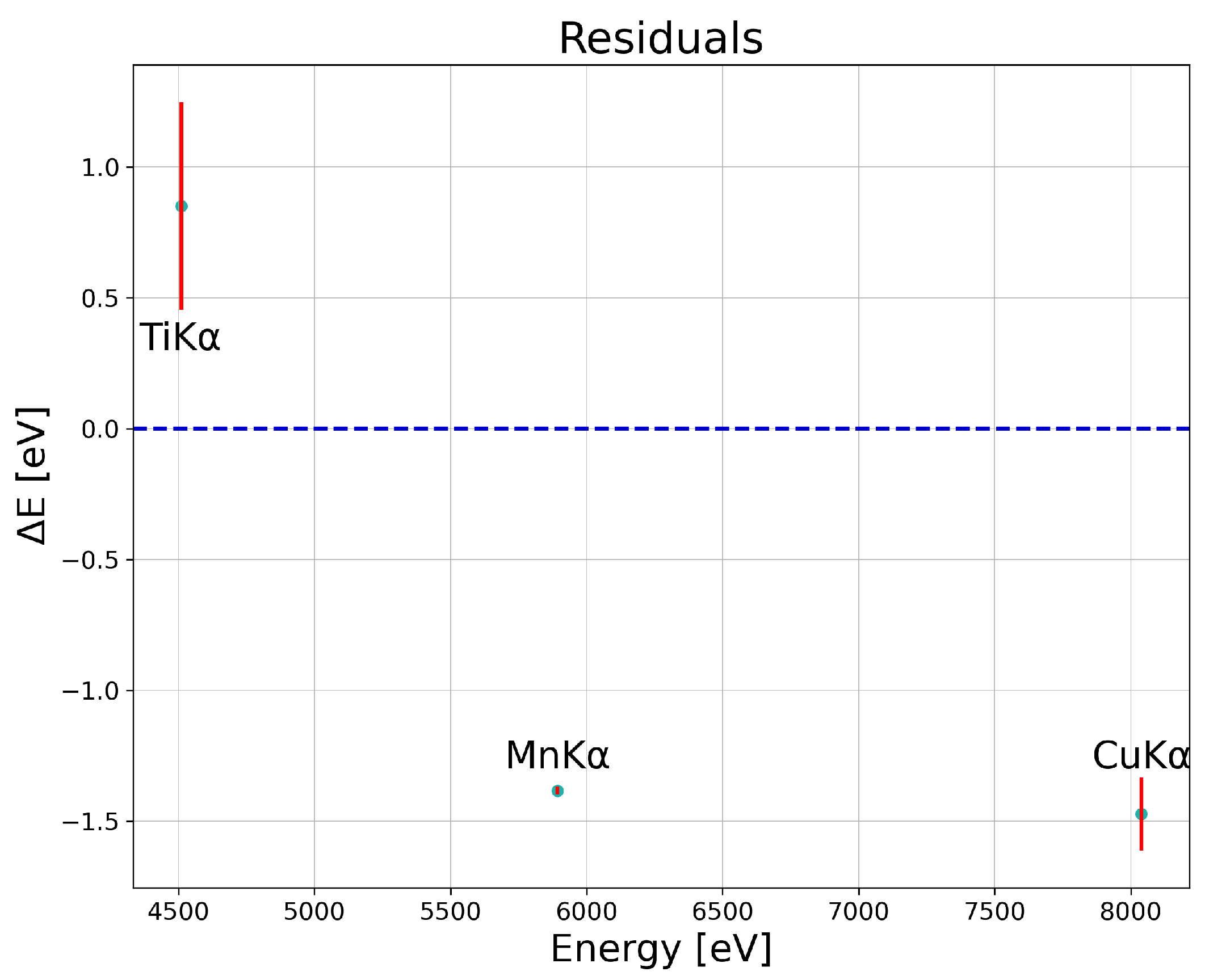
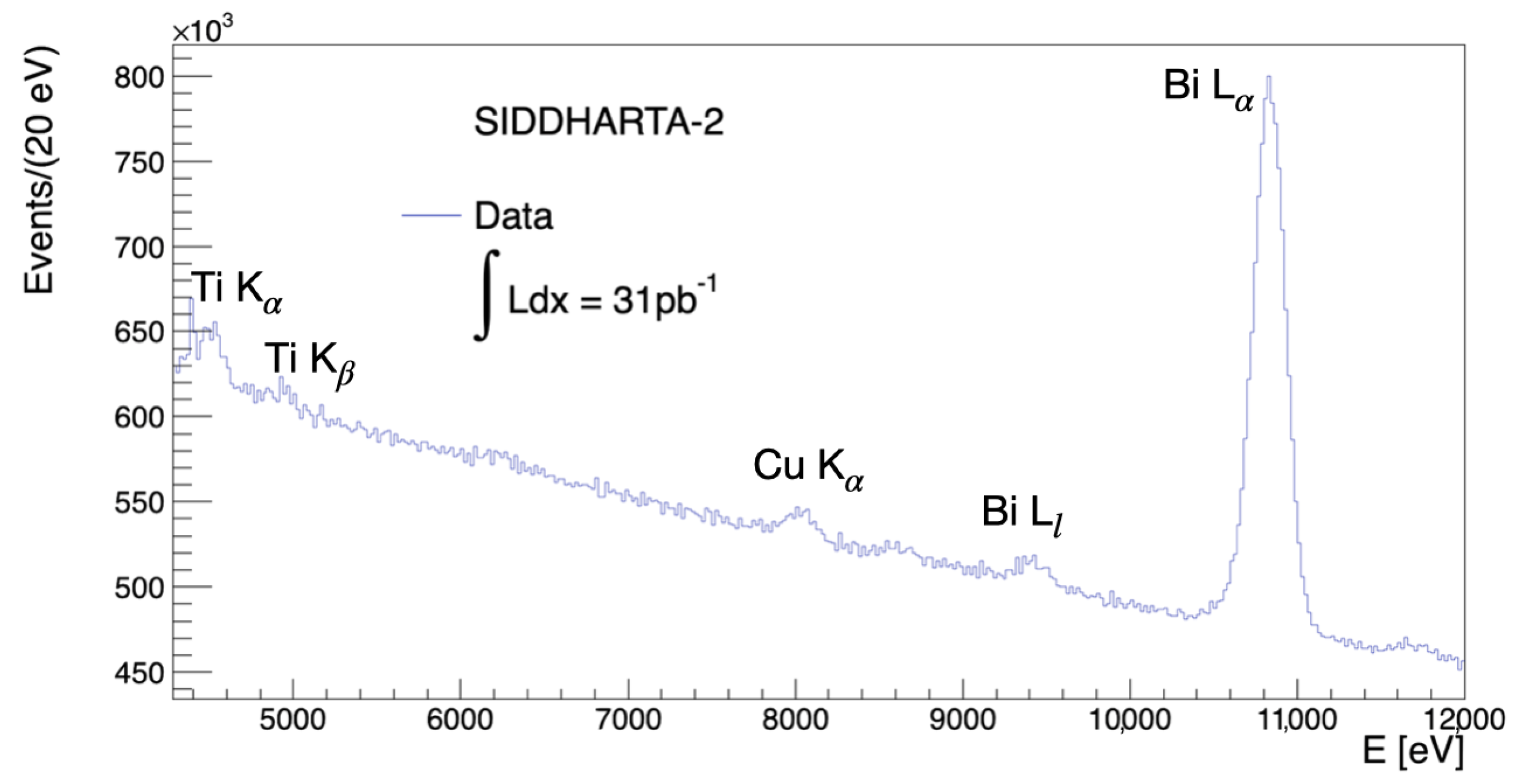
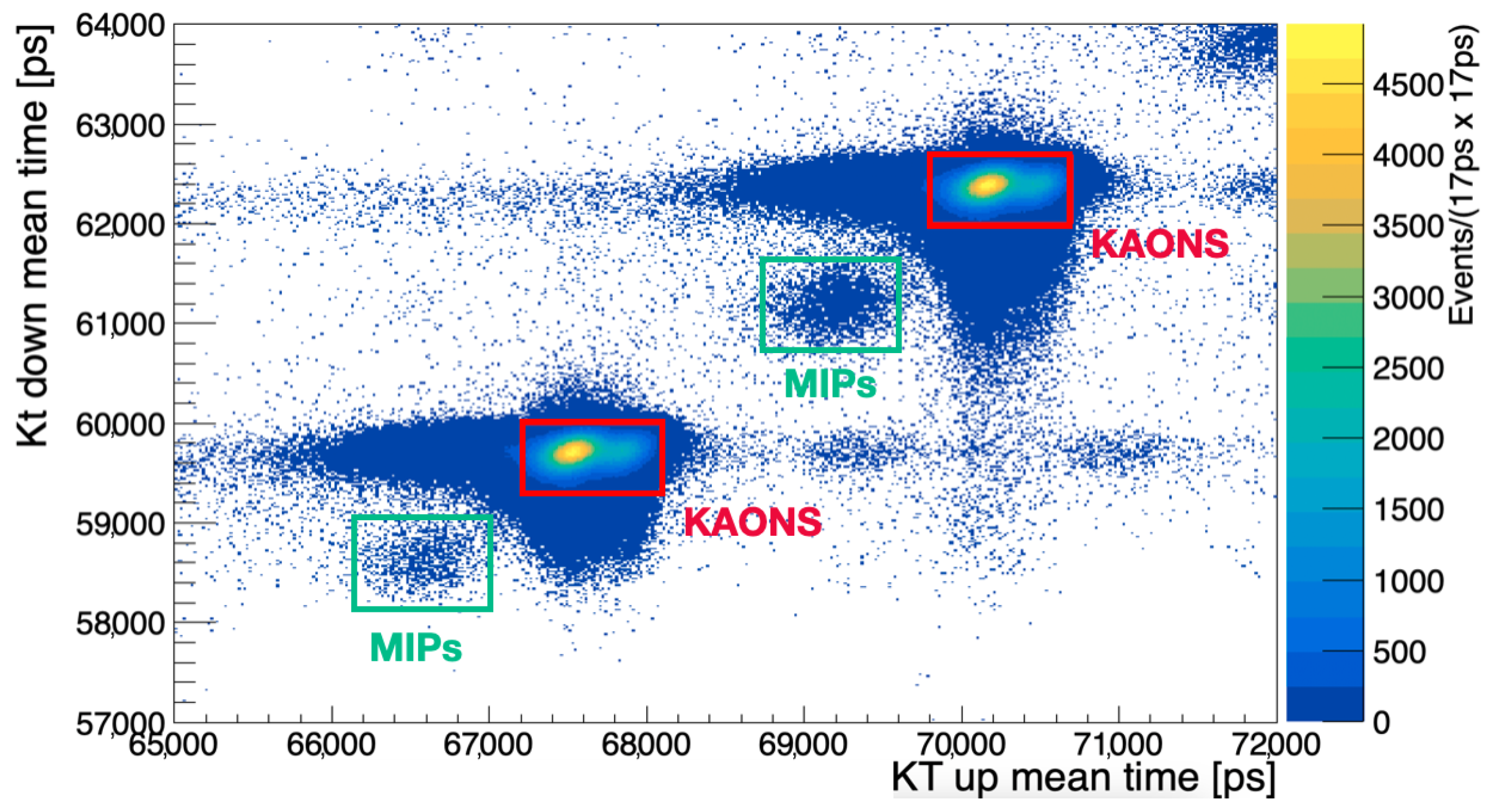


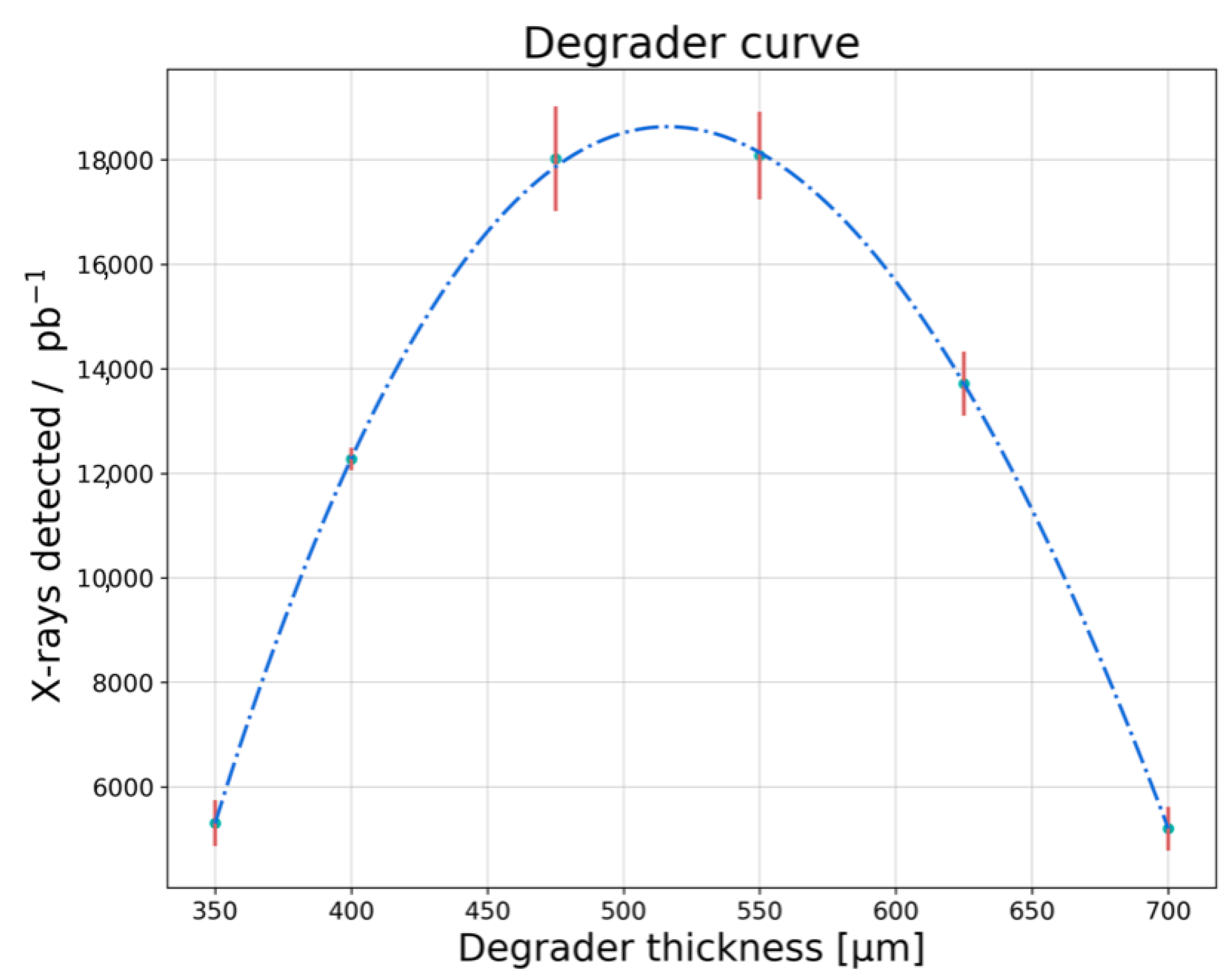
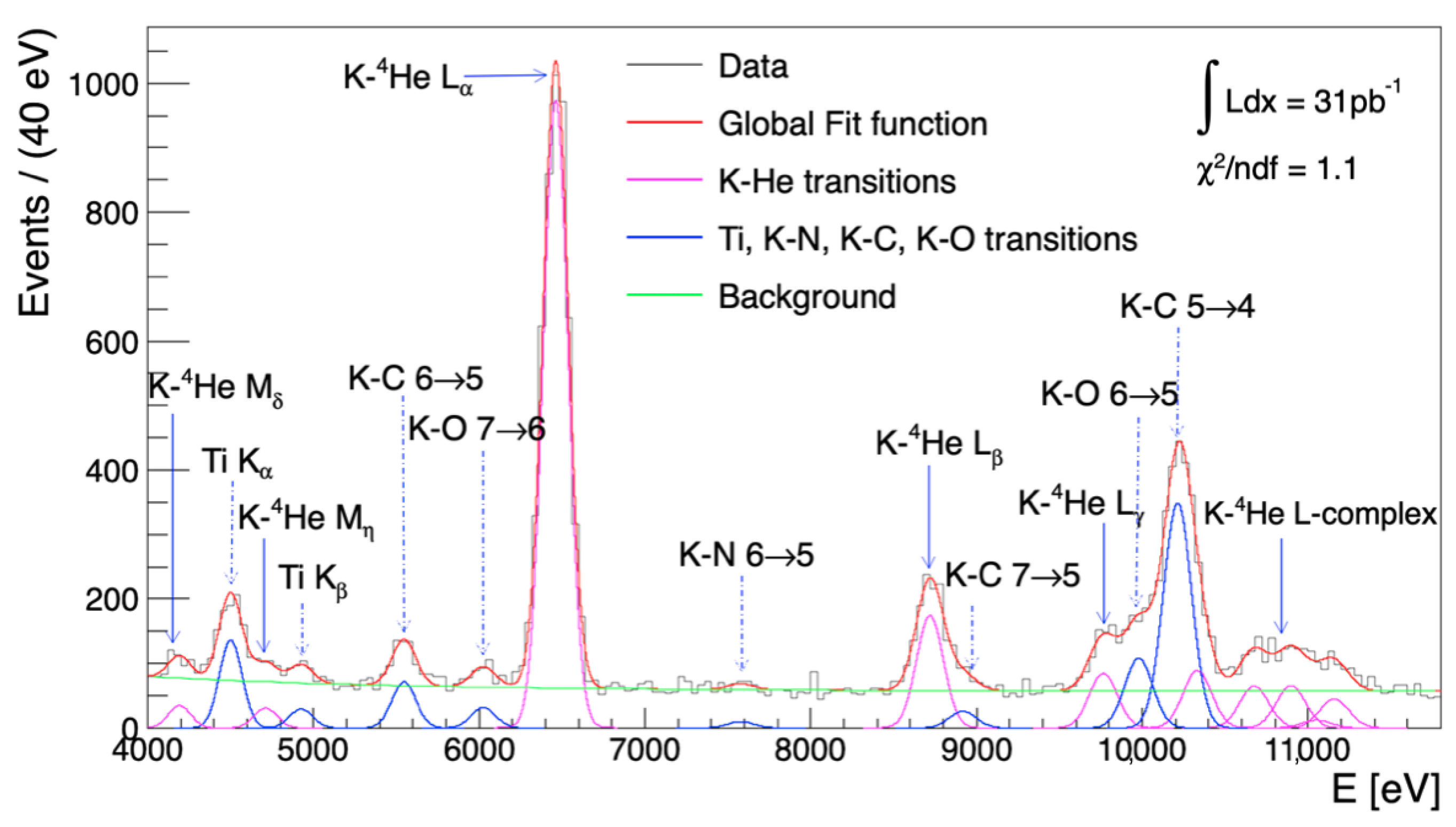
Disclaimer/Publisher’s Note: The statements, opinions and data contained in all publications are solely those of the individual author(s) and contributor(s) and not of MDPI and/or the editor(s). MDPI and/or the editor(s) disclaim responsibility for any injury to people or property resulting from any ideas, methods, instructions or products referred to in the content. |
© 2024 by the authors. Licensee MDPI, Basel, Switzerland. This article is an open access article distributed under the terms and conditions of the Creative Commons Attribution (CC BY) license (https://creativecommons.org/licenses/by/4.0/).
Share and Cite
Sgaramella, F.; Clozza, F.; Abbene, L.; Artibani, F.; Bazzi, M.; Borghi, G.; Bragadireanu, M.; Buttacavoli, A.; Cargnelli, M.; Carminati, M.; et al. Characterization of the SIDDHARTA-2 Setup via the Kaonic Helium Measurement. Condens. Matter 2024, 9, 16. https://doi.org/10.3390/condmat9010016
Sgaramella F, Clozza F, Abbene L, Artibani F, Bazzi M, Borghi G, Bragadireanu M, Buttacavoli A, Cargnelli M, Carminati M, et al. Characterization of the SIDDHARTA-2 Setup via the Kaonic Helium Measurement. Condensed Matter. 2024; 9(1):16. https://doi.org/10.3390/condmat9010016
Chicago/Turabian StyleSgaramella, Francesco, Francesco Clozza, Leonardo Abbene, Francesco Artibani, Massimiliano Bazzi, Giacomo Borghi, Mario Bragadireanu, Antonino Buttacavoli, Michael Cargnelli, Marco Carminati, and et al. 2024. "Characterization of the SIDDHARTA-2 Setup via the Kaonic Helium Measurement" Condensed Matter 9, no. 1: 16. https://doi.org/10.3390/condmat9010016
APA StyleSgaramella, F., Clozza, F., Abbene, L., Artibani, F., Bazzi, M., Borghi, G., Bragadireanu, M., Buttacavoli, A., Cargnelli, M., Carminati, M., Clozza, A., Deda, G., Del Grande, R., De Paolis, L., Dulski, K., Fiorini, C., Guaraldo, C., Iliescu, M., Iwasaki, M., ... Curceanu, C. (2024). Characterization of the SIDDHARTA-2 Setup via the Kaonic Helium Measurement. Condensed Matter, 9(1), 16. https://doi.org/10.3390/condmat9010016











